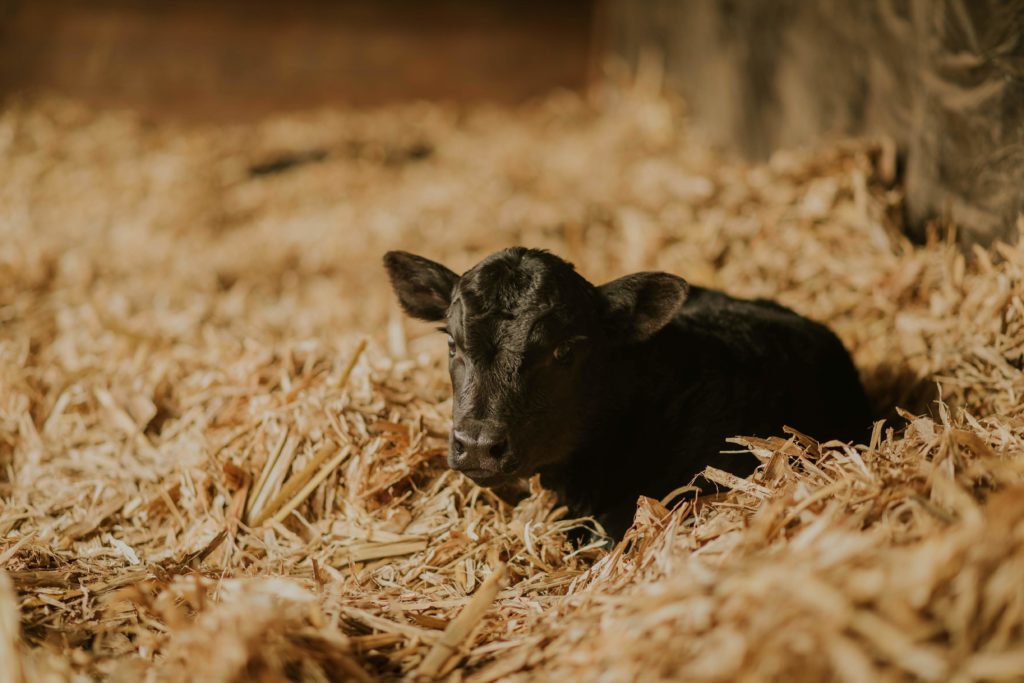Everyone knows summer heat can have a large impact on a dairy herd, but the impact on calves is often overlooked. Heat stress can have long term effects on the future productivity of growing heifers. As calves feel the summer heat, help keep them comfortable by following a few simple cooling practices.
A calf’s body temperature will rise and fall with the surrounding air temperature. When night temperatures remain above 78°F, calves are unable to return to their normal body temperature. Installing fans in a calf nursery has been shown to slow breathing rates and increase growth by 15% (Bateman, 2012). Installing shade structures over calf hutches can also greatly reduce the air temperature inside by up to 5.4°F, helping reduce the effort of keeping cool.
Similar to lactating cows, calves also consume less feed during heat waves. Growth rates would be expected to drop accordingly, and as shown in Figure 1, growth rate decreases by a greater amount than feed intake as temperature increases. Calves expend energy to keep cool, primarily by panting. This means energy for maintenance is increased leaving less energy available for growth.
Research has found immunoglobulin concentrations in the blood of calves born during heat stress are reduced due to failure of passive transfer (FPT) (Hill et al., 2012). This occurs not only because cows produce lower levels of immunoglobulin in their colostrum when heat stressed, but a calf’s ability to absorb these immune proteins is also diminished.
In a study comparing calves raised in three environments, cold (23°F), thermo neutral (74°F), and hot (95°F), the calves exposed to the hot conditions showed immunoglobulin levels 27% lower than the calves in the thermo neutral environment which resulted in higher mortality. Hutches are poor environments for calves in areas of extreme heat. Particularly when positioned in the sun, hutches trap heat and reduce air flow to cool the calf inside. In Figure 2, cortisol levels are higher when the calf is housed in a hotter environment such as a calf hutch. Cortisol is a hormone produced in higher levels during stress. Looking back at the graph, immunoglobulin concentration in the blood of calves decreases as cortisol levels rise demonstrating calves are less able to absorb colostral immunoglobulins when exposed to stress from hot environments.
Research has found immunoglobulin concentrations in the blood of calves born during heat stress are reduced due to failure of passive transfer (FPT) (Hill et al., 2012). This occurs not only because cows produce lower levels of immunoglobulin in their colostrum when heat stressed, but a calf’s ability to absorb these immune proteins is also diminished.
In a study comparing calves raised in three environments, cold (23°F), thermo neutral (74°F), and hot (95°F), the calves exposed to the hot conditions showed immunoglobulin levels 27% lower than the calves in the thermo neutral environment which resulted in higher mortality. Hutches are poor environments for calves in areas of extreme heat. Particularly when positioned in the sun, hutches trap heat and reduce air flow to cool the calf inside. In Figure 2, cortisol levels are higher when the calf is housed in a hotter environment such as a calf hutch. Cortisol is a hormone produced in higher levels during stress. Looking back at the graph, immunoglobulin concentration in the blood of calves decreases as cortisol levels rise demonstrating calves are less able to absorb colostral immunoglobulins when exposed to stress from hot environments.
Lower immunoglobulin levels can also lead to increased cost of treatment, lower milk production, and reduced growth rates, subsequently delaying pregnancy. To avoid these outcomes, it can be beneficial to provide calves born during times of heat stress with a colostrum supplement or replacer to ensure high levels of immunoglobulin available for uptake by the calf.
Ultimately, taking steps to reduce heat stress in calves will result in increased profits long term. Calves can drink anywhere from 11 to 22 liters of water per day to replace fluids lost trying to stay cool (Bungert, 1998). For this reason it is very important to provide clean free choice water to calves at all times. A method of reducing the air temperature inside calf hutches is building shade structures over the hutches. As well as reducing air temperature, air movement is also crucial as is allowing evaporative cooling of the calf so proper ventilation should be in place. All these methods used in conjunction with providing a colostrum supplement or replacer at birth will set your calves well on their way to leading long, healthy productive lives.


References
G. Bateman, M. Hill. 2012. “How heat stress impacts the growth of calves.” Dairy Basics; April
K. Bungert. 1998. “Calves feel the heat too.” Dairy Herd Management; 35, 5: 15.
T.M. Hill, H.G. Bateman II, J.M. Aldrich, R.L. Schlotterbeck. 2012. “Case Study: Effect of feeding rate and weaning age of dairy calves fed a conventional milk replacer during warm summer months.” Professional Animal Scientist 28:125-130
J.N. Spain, D.E. Spiers. 1996. “Effects of Supplemental Shade on Thermoregulatory Response of Calves to Heat Challenge in a Hutch Environment.” Journal of Dairy Science Vol. 79, No. 4.
Stott et al. 1975. J Dairy Sci. 59:1306 – 1311
